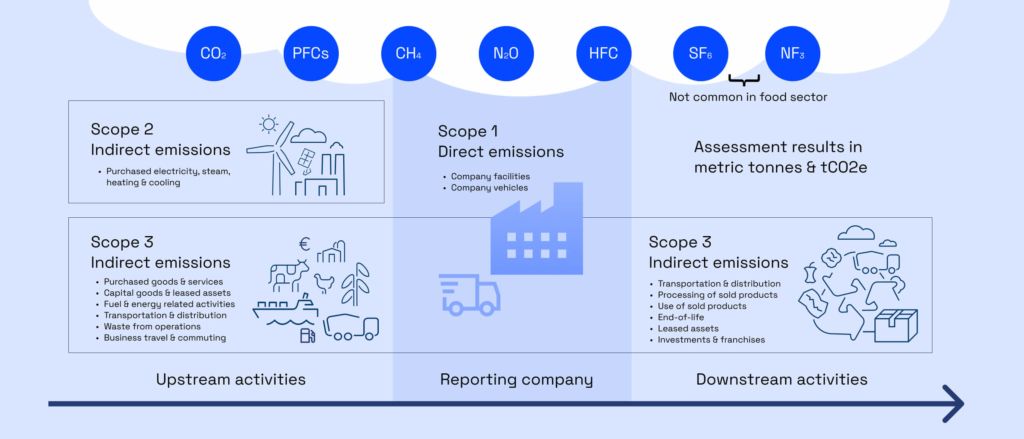
Greenhouse Gas emissions & the GHG Protocol

Greenhouse Gases (GHGs) and escalating emissions have long been at the centre of global climate conversations – also within the Food Sector. But for sustainability experts, how does this translate to daily operations, and how can we use the GHG Protocol, the most commonly used industry standards, as a tools for change? This article dives into these concepts, tailored specifically for those who are shaping the future of food.
What are the Greenhouse Gases (GHGs)?
Greenhouse Gases are atmospheric gases responsible for the greenhouse effect, a natural process where certain gases trap heat in the Earth’s atmosphere, regulating our planet’s temperature. The primary GHGs are:
- Carbon Dioxide (CO2)
- Methane (CH4)
- Nitrous Oxide (N2O), and
- Fluorinated Gases, including HFC, PFC, SF6 and NF3
Carbon dioxide currently accounts for the biggest share of the climate warming associated with human activities, but the other gases have much larger impacts per unit of gas emitted.
Human activities, like agriculture and food production, have intensified these emissions, leading to imbalances and global climate change. Fossil fuels – coal, oil and gas – are the largest contributors to climate change. They are causing 75 % of global greenhouse gas emissions and 90 % of all carbon dioxide emissions.
The GHG Protocol and the Food Industry
The GHG Protocol provides a framework for measuring, managing, and reporting GHG emissions. For the food industry, this can be a roadmap for both understanding our impact and devising strategies to mitigate harmful activities. Both the Product Environmental Footprint (PEF) and the Greenhouse Gas (GHG) Protocol aim to guide and standardize the assessment of environmental impacts, but they have different scopes, methodologies, and purposes.

Key takeaways from the GHG Protocol for the food industry:
- Scope Classification: The Greenhouse Gas Protocol classifies emissions into three categories:
- Direct emissions from own activities (scope 1),
- Indirect emissions from purchased and consumed energy (scope 2),
- Direct and indirect emissions from the value chain (scope 3).
- Sector Guidance: Specific guidelines help address unique emission sources in our industry, ensuring that we’re measuring and managing our emissions with precision.
- Product Life Cycle Analysis: Especially relevant for the food industry, this aspect of the GHG Protocol helps in understanding the emissions produced throughout a product’s life – from farm to table.
For sustainability experts in the food industry, understanding GHGs and the tools available for their measurement and management is paramount. The GHG Protocol can be a great ally, guiding us toward a more sustainable, climate-friendly future. As we continue to feed the world, let’s ensure that we’re also nurturing our planet.

The Food Industry’s Role in GHG Emissions:
The food industry is a big actor in the GHG narrative. From agricultural practices that release methane and nitrous oxides to energy-intensive processing plants, our industry is both a significant emitter and a potential leader in GHG reduction.
- Agriculture: Activities such as rice cultivation, enteric fermentation from ruminants, and the use of synthetic fertilizers release large amounts of methane and nitrous oxides.
- Processing and Packaging: The energy used in these steps, often from burning fossil fuels, results in significant CO2 emissions.
- Distribution: The transportation of food products, especially cold storage transportation, is another source of emissions.
- Waste: Decomposition of organic waste in landfills produces methane.
👉 Further reading: 10 ways for food companies to reduce carbon footprint
Contact us
We’re happy to answer questions and get you acquainted with Biocode.
Are you unsure where to start your climate work?
Explore use cases for your company
Get pricing information
If you are looking for help to calculate and manage your climate impact, contact us!
Stay tuned and subscribe to our messages about the climate, food industry and food supply chain



